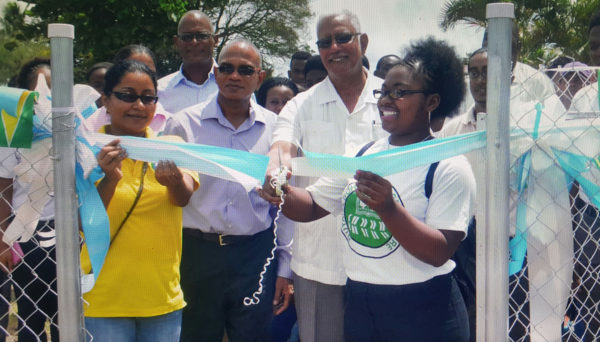The Hydrometeorological Service has commissioned a $1.6 M Climatological Station at the Guyana School of Agriculture (GSA) that is expected to assist with seasonal forecasting to improve agricultural production.
In his feature address at the commissioning yesterday, Minister of Agricul-ture Noel Holder emphasised the importance of measures to mitigate the effects of climate change, while highlighting losses in production of nearly $5B following a prolonged drought.
The instruments will enable the collection of rainfall, air temperature, wind speed, sunshine and evaporation. The data collected will provide the opportunity for more focused research in crop production, adaptation, improved resilience or other suitable interventions to cope with the changes in climate. It also allows for analysis in real time in strategic locations.

Climatologist (ag) at the Hydromet Service Komalchand Dhiram pointed out that the station will be used mainly for observational purposes but would also function as a means to carry out seasonal forecasting.
He said the data gathered would help farmers to know what crops to plant.
It is the eleventh station that has been commissioned and Dhiram noted that “the more stations we have in a specific grid gives a wider scope, which will allow for a more accurate forecast.”
Minister Holder said that the establishment of the station is a step in this direction and should be viewed as beneficial to both the Hydromet Service and the GSA.
He noted that given that agriculture is a pillar of the productive sector and contributes significantly to Guyana’s Gross Domestic Product, the station is an intervention towards improving agricultural output. “As part of the effort to support hinterland agriculture, we have and will continue to re-operationalise a number of weather stations across the country; specifically, the Wauna Climate Metrologi-cal Station in Barima-Waini, in Region One, and the Kato Weather station in Region Eight,” he further said.
He said it is a part of the ministry’s effort to ensure that weather changes and climatic conditions are correctly recorded in order to foster improved agricultural practices.
Furthermore, he noted that the ministry is expanding its “data collection network in tidal areas influenced by the sea to get an indication of the rise in sea level which can threaten our coastal agricultural activities.”
The data will aid in the improvements in both agricultural practices and production in this era of global climate change.
Holder recalled that during the recent drought, the sector experienced an estimated loss of $ 4.8B in production from 33,231 acres in rice, sugar cane, cash crops, livestock and fisheries. As a result, he said, “It is vital that we enforce measures to mitigate the effects of climate change.”
The minister added: “Usually the effects of climate change are magnified and multiplied in poor communities. That is precisely why global meteorological centers have focused on generating forecasts. The Ministry of Agriculture, through its national weather service’s hydromet office, permits the public to be more climate smart, using climate and weather information to make informed decisions.”
He also noted the need to provide “people with the timely information they need to protect themselves from extreme weather conditions.”
As a result of the set-up of the station, some 120 students per year are expected to benefit from practical experience in Agricultural Metrology and Holder noted that the facility will enable them to link theory with practice and be more knowledgeable in reading and recording climate instruments.
Chief Executive Officer of the GSA Brian Greenidge said the establishment of the station is of major significance and that it comes at a time when the school is moving towards its service delivery.
He said a committee, comprising of a diversity of institutions and agencies, would be set up to review the curriculum to make it more responsive and effective.
Greenidge recalled that four years ago an approach was made to the hydromet department for the centre to be set up at the GSA. The idea was for it to support in the meteorological aspect of the school’s agricultural certificate and diploma programmes. Greenidge was happy that having the station on the campus was finally a reality.
He acknowledged that in the process of waiting, an automatic weather station was installed at the Essequibo campus, as a result of prior collaborative work between the school and the hydromet service.




